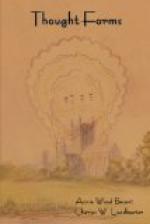[Illustration: FIG. 34. AT A FUNERAL]
It is refreshing to turn from this gloomy picture to the wonderfully different effect produced by the very same circumstances upon the mind of the man who comprehends the facts of the case. It will be observed that the two have no single emotion in common; in the former case all was despondency and horror, while in this case we find none but the highest and most beautiful sentiments. At the base of the thought-form we find a full expression of deep sympathy, the lighter green indicating appreciation of the suffering of the mourners and condolence with them, while the band of deeper green shows the attitude of the thinker towards the dead man himself. The deep rose-colour exhibits affection towards both the dead and the living, while the upper part of the cone and the stars which rise from it testify to the feeling aroused within the thinker by the consideration of the subject of death, the blue expressing its devotional aspect, while the violet shows the thought of, and the power to respond to, a noble ideal, and the golden stars denote the spiritual aspirations which its contemplation calls forth. The band of clear yellow which is seen in the centre of this thought-form is very significant, as indicating that the man’s whole attitude is based upon and prompted by his intellectual comprehension of the situation, and this is also shown by the regularity of the arrangement of the colours and the definiteness of the lines of demarcation between them.
The comparison between the two illustrations shown in this plate is surely a very impressive testimony to the value of the knowledge given by the theosophical teaching. Undoubtedly this knowledge of the truth takes away all fear of death, and makes life easier to live because we understand its object and its end, and we realise that death is a perfectly natural incident in its course, a necessary step in our evolution.




